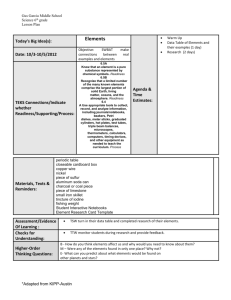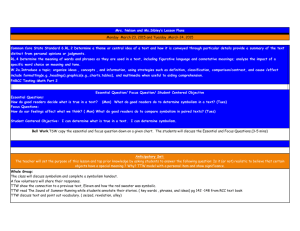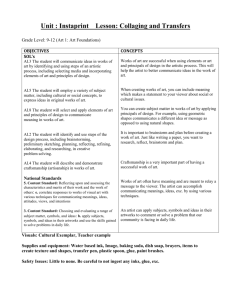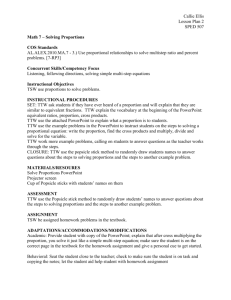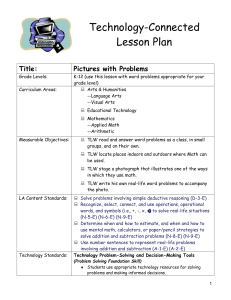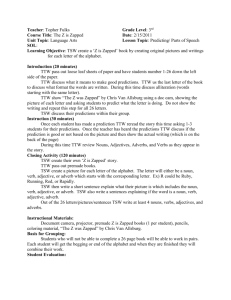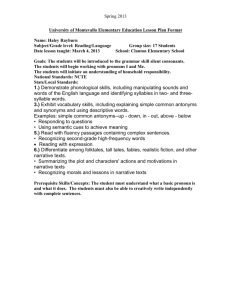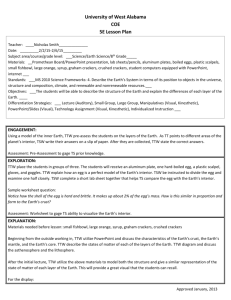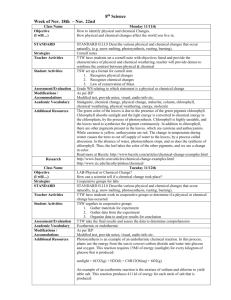Day_1._Central_Dogma_Theory.doc
advertisement
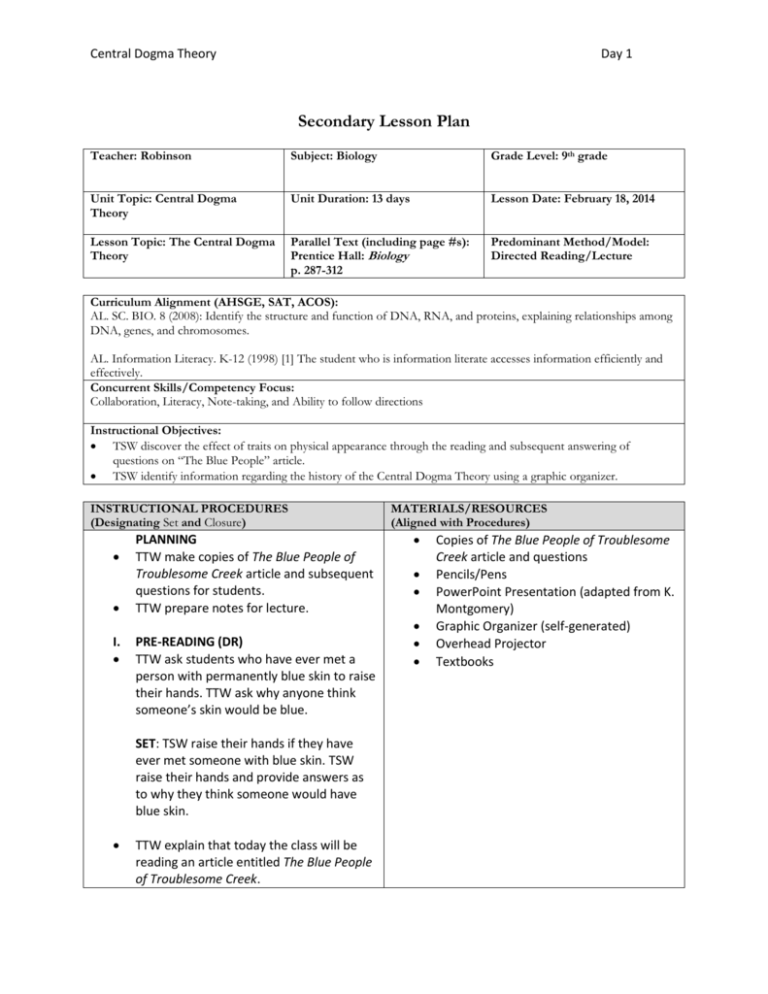
Central Dogma Theory Day 1 Secondary Lesson Plan Teacher: Robinson Subject: Biology Grade Level: 9th grade Unit Topic: Central Dogma Theory Unit Duration: 13 days Lesson Date: February 18, 2014 Lesson Topic: The Central Dogma Theory Parallel Text (including page #s): Prentice Hall: Biology p. 287-312 Predominant Method/Model: Directed Reading/Lecture Curriculum Alignment (AHSGE, SAT, ACOS): AL. SC. BIO. 8 (2008): Identify the structure and function of DNA, RNA, and proteins, explaining relationships among DNA, genes, and chromosomes. AL. Information Literacy. K-12 (1998) [1] The student who is information literate accesses information efficiently and effectively. Concurrent Skills/Competency Focus: Collaboration, Literacy, Note-taking, and Ability to follow directions Instructional Objectives: TSW discover the effect of traits on physical appearance through the reading and subsequent answering of questions on “The Blue People” article. TSW identify information regarding the history of the Central Dogma Theory using a graphic organizer. INSTRUCTIONAL PROCEDURES (Designating Set and Closure) I. PLANNING TTW make copies of The Blue People of Troublesome Creek article and subsequent questions for students. TTW prepare notes for lecture. PRE-READING (DR) TTW ask students who have ever met a person with permanently blue skin to raise their hands. TTW ask why anyone think someone’s skin would be blue. SET: TSW raise their hands if they have ever met someone with blue skin. TSW raise their hands and provide answers as to why they think someone would have blue skin. TTW explain that today the class will be reading an article entitled The Blue People of Troublesome Creek. MATERIALS/RESOURCES (Aligned with Procedures) Copies of The Blue People of Troublesome Creek article and questions Pencils/Pens PowerPoint Presentation (adapted from K. Montgomery) Graphic Organizer (self-generated) Overhead Projector Textbooks Central Dogma Theory - TTW explain that the point in reading this article is to introduce the topic of the next unit, The Central Dogma unit. In this unit, students will learn about DNA, RNA, proteins, and the processes to make each within the body. TTW explain that each of these plays a role in helping to express certain characteristics, and the goal in reading this article is to observe what can happen when things do not function properly. TTW tell students to highlight or underline words that are unfamiliar while reading the article. TTW explain that the article is a narrative and students should be able to follow the storyline without difficulty. After reading the article, TSW answer questions that have students identify and define the terms that are specified in the article. Students then use those terms to analyze how and why the disorder occurred. TTW ask students to explain what they are about to do. TTW ask students why this article is being read. II. CONCURRENT READING (DR) TTW pass out the article and questions to the students. TTW remind students to write questions or things that stick out in the margins and to underline or highlight words that stick out or are unfamiliar. III. POST READING (DR) TTW ask students to get out the questions that were given with the article. TTW ask students to point out any sections that seemed unclear or of interest. TTW briefly go over the questions with students and ask them to finish the questions for homework. TTW ask students to put away the article/questions. Day 1 Central Dogma Theory Day 1 IV. PRESENTATION (LECTURE) TTW explain that for the remainder of the period students will take notes on the history of research relating to the Central Dogma Theory using a graphic organizer. TTW pass out a copy of the graphic organizer to students. TTW use a PowerPoint presentation to give notes. TTW ask questions periodically throughout the lesson to assess the level of understanding about each experiment and researcher discussed. VI. CLOSURE (LECTURE) TTW explain that in the next few weeks, students will be learning about the different processes that were discovered as a result of the research contributed. TTW ask how the research that was conducted by the various scientists discussed in lecture could help with understanding the blue people discussed at the beginning of class. CLOSURE: TSW discuss ways the research conducted by the various scientists discussed in lecture could help with understanding the blue people discussed at the beginning of class. TTW remind students to study for their test the following day on Photosynthesis and Cellular Respiration. TTW ask students to finish their worksheets and turn them in on Friday, February 21. Assessment (Of Objectives) ASSIGNMENT (For Review, Practice, and/or Extension) Questions from The Blue People of Troublesome Creek will be reviewed for accuracy and to ensure concept attainment. Questions from The Blue People of Troublesome Creek Central Dogma Theory The Blue People of Troublesome Creek Reading Questions Day 1 Name 1. Use your textbook to define the term “trait”. 2. What physical trait was studied in this article? 3. Each trait can have variations. For example, the trait of seed color can have the variations of green seed color or yellow seed color. What physical VARIATION of the trait from #2 did Martin Fugate and his wife pass on to their many generations of offspring? 4. What was the speculation for why this variation was present? 5. What heredity blood disorder did Cawein discover was affecting the “blue people”? 6. What do you think the term “hereditary” means? 7. What is methemoglobin? 8. Cawein concluded that the blue peoples’ methmoglobinemia was caused by a missing enzyme called ____________. 9. Use your textbook to define the term “enzyme”. 10. For a person to have this disorder, he or she must inherit the gene from each parent. What term is given for this? 11. Use your textbook to define the term “gene”. 12. How, or why, did this recessive disorder continue to multiply in this small family? 13. Based on this reading and your response to the questions, describe the relationship between enzymes (proteins) and traits.
